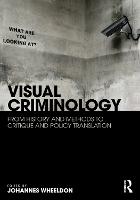


|
|
|
books
| book details |
Visual Criminology: From History and Methods to Critique and Policy Translation
Edited by Johannes Wheeldon

|
This book is currently unavailable. Enquire to check if we can source a used copy
|
| book description |
This edited collection captures the expertise of scholars from the US, the UK, Australia, and Canada to catalog the rise in visual approaches in criminology. It presents examples of visual methods, uses, and approaches in criminology; assesses the potential for new graphic approaches to collect, analyze, and present data; and provides some analysis of the use of images in teaching, to spur social critique, and guide policy translation. The collection visually connects theory and practice by highlighting the work of criminologists who have embraced the visual turn. Contributors explore the use of cognitive maps, concept and mind maps, life history calendars, CCTV, life plots, GIS and hot spot research, policy graphs, visual abstracts and research summaries,and other visual tools in the context of criminology. Approaches building on visual sociology are also featured, including a discussion of developments in documentary photography and film, visual ethnography, and sensory phenomenology. The book is organized thematically, with each chapter following logically upon the last, introducing readers to a variety of visual approaches and their application in criminology. The goals of this collected volume are three-fold. The first is to highlight how the visual has been used in criminology historically to present data, contest meaning and complicate social control, and make more transparent the research process. The second is to work toward some sort of definitional consistency. While a worthy endeavor, this remains elusive given the assortment of uses and varying traditions from which visual criminology has emerged. The third is to try to think clearly about the role of humility. This means a willingness to acknowledge an epistemological framework and note the variety of limitations associated with trying to understand in deep and meaningful ways. For visual criminology specifically, it involves the recognition that part of the power of images (whatever their construction), comes from whether we think they are beautiful or whether and/or to what extent they disrupt our understanding in one way or another. This interdisciplinary book will be of interest to criminologists, sociologists, visual ethnographers, historians and those engaged with media studies. It is a valuable supplementary text for courses in introductory criminology and criminal justice, criminological theory, research methods, and other upper-level and senior capstone courses.
| product details |
Normally shipped |
Publisher | Taylor & Francis Ltd
Published date | 1 Oct 2021
Language |
Format | Digital (delivered electronically)
Pages | 332
Dimensions | 0 x 0 x 0mm (L x W x H)
Weight | 0g
ISBN | 978-1-0004-3176-6
Readership Age |
BISAC | social science / criminology
| other options |
|
|
|
To view the items in your trolley please sign in.
| sign in |
|
|
|
| specials |
|

|
André Alexis
Paperback / softback
176 pages
was: R 280.95
now: R 252.95
|
A pack of dogs are granted the power of human thought - but what will it do to them? A surprising and insightful look at the beauty and perils of consciousness.
|
Our moment has seen the resurgence of an anarchist sensibility, from the uprisings in Seattle in 1999 to the Occupy movement of 2011.
|

|
Carl Morrow
Paperback / softback
160 pages
was: R 320.95
now: R 288.95
|
In this uniquely Southern African book, Carl Morrow and Keith Kirsten guide readers step by step into the magical realms of bonsai as a hobby, horticultural practice and art form.
|
|
|
|